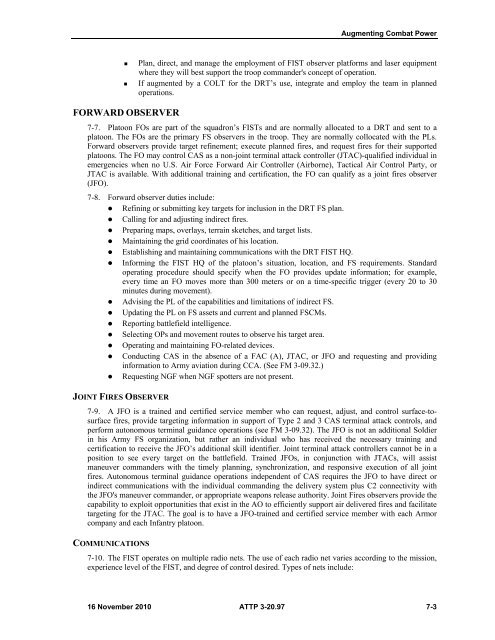Dismounted Reconnaissance Troop - Army Electronic Publications ...
Dismounted Reconnaissance Troop - Army Electronic Publications ...
Dismounted Reconnaissance Troop - Army Electronic Publications ...
You also want an ePaper? Increase the reach of your titles
YUMPU automatically turns print PDFs into web optimized ePapers that Google loves.
Augmenting Combat Power<br />
Plan, direct, and manage the employment of FIST observer platforms and laser equipment<br />
where they will best support the troop commander's concept of operation.<br />
If augmented by a COLT for the DRT’s use, integrate and employ the team in planned<br />
operations.<br />
FORWARD OBSERVER<br />
7-7. Platoon FOs are part of the squadron’s FISTs and are normally allocated to a DRT and sent to a<br />
platoon. The FOs are the primary FS observers in the troop. They are normally collocated with the PLs.<br />
Forward observers provide target refinement; execute planned fires, and request fires for their supported<br />
platoons. The FO may control CAS as a non-joint terminal attack controller (JTAC)-qualified individual in<br />
emergencies when no U.S. Air Force Forward Air Controller (Airborne), Tactical Air Control Party, or<br />
JTAC is available. With additional training and certification, the FO can qualify as a joint fires observer<br />
(JFO).<br />
7-8. Forward observer duties include:<br />
Refining or submitting key targets for inclusion in the DRT FS plan.<br />
Calling for and adjusting indirect fires.<br />
Preparing maps, overlays, terrain sketches, and target lists.<br />
Maintaining the grid coordinates of his location.<br />
Establishing and maintaining communications with the DRT FIST HQ.<br />
Informing the FIST HQ of the platoon’s situation, location, and FS requirements. Standard<br />
operating procedure should specify when the FO provides update information; for example,<br />
every time an FO moves more than 300 meters or on a time-specific trigger (every 20 to 30<br />
minutes during movement).<br />
Advising the PL of the capabilities and limitations of indirect FS.<br />
Updating the PL on FS assets and current and planned FSCMs.<br />
Reporting battlefield intelligence.<br />
Selecting OPs and movement routes to observe his target area.<br />
Operating and maintaining FO-related devices.<br />
Conducting CAS in the absence of a FAC (A), JTAC, or JFO and requesting and providing<br />
information to <strong>Army</strong> aviation during CCA. (See FM 3-09.32.)<br />
Requesting NGF when NGF spotters are not present.<br />
JOINT FIRES OBSERVER<br />
7-9. A JFO is a trained and certified service member who can request, adjust, and control surface-tosurface<br />
fires, provide targeting information in support of Type 2 and 3 CAS terminal attack controls, and<br />
perform autonomous terminal guidance operations (see FM 3-09.32). The JFO is not an additional Soldier<br />
in his <strong>Army</strong> FS organization, but rather an individual who has received the necessary training and<br />
certification to receive the JFO’s additional skill identifier. Joint terminal attack controllers cannot be in a<br />
position to see every target on the battlefield. Trained JFOs, in conjunction with JTACs, will assist<br />
maneuver commanders with the timely planning, synchronization, and responsive execution of all joint<br />
fires. Autonomous terminal guidance operations independent of CAS requires the JFO to have direct or<br />
indirect communications with the individual commanding the delivery system plus C2 connectivity with<br />
the JFO's maneuver commander, or appropriate weapons release authority. Joint Fires observers provide the<br />
capability to exploit opportunities that exist in the AO to efficiently support air delivered fires and facilitate<br />
targeting for the JTAC. The goal is to have a JFO-trained and certified service member with each Armor<br />
company and each Infantry platoon.<br />
COMMUNICATIONS<br />
7-10. The FIST operates on multiple radio nets. The use of each radio net varies according to the mission,<br />
experience level of the FIST, and degree of control desired. Types of nets include:<br />
16 November 2010 ATTP 3-20.97 7-3

















